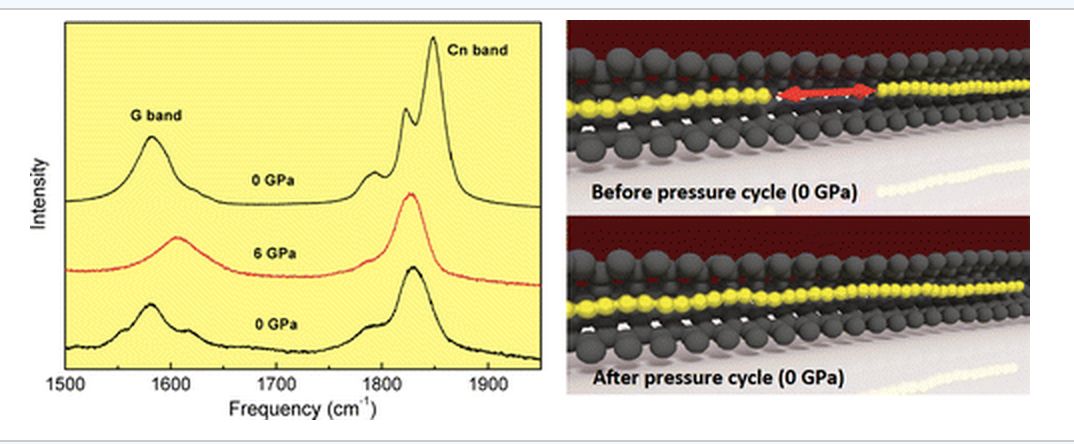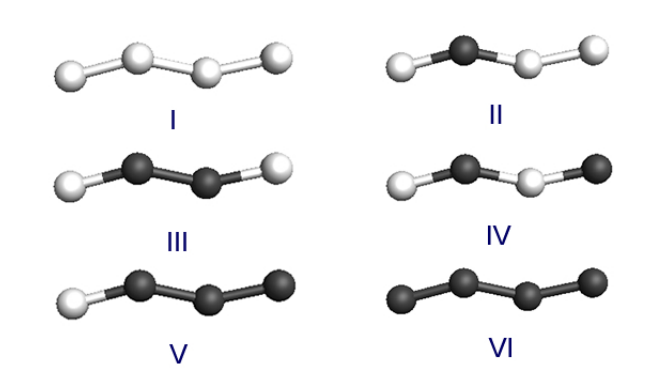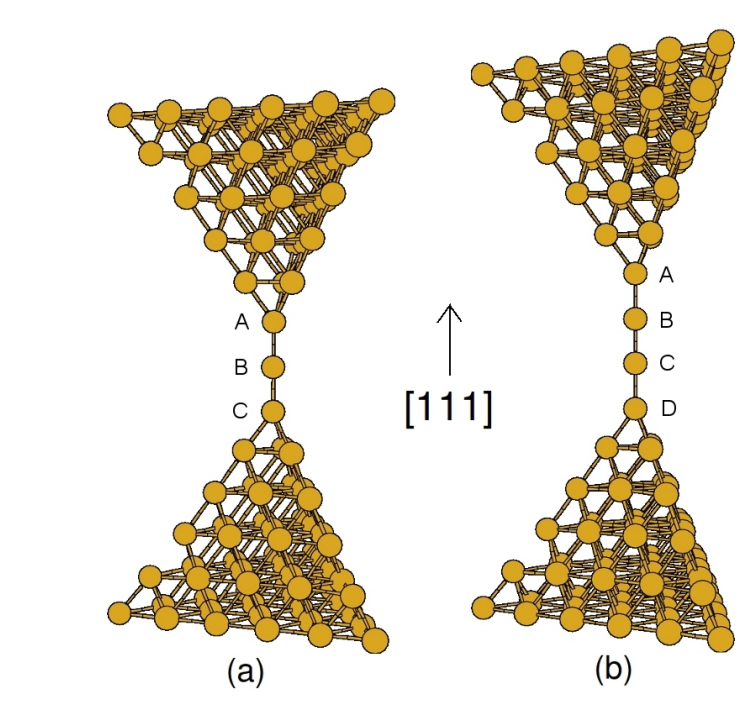Acrísio L Aguiar Nadia Ferreira Andrade, Yoong Ahm Kim
Linear Carbon Chains Under High Pressure Conditions Journal Article
In: The Journal of Physical Chemistry C, vol. 119, no. 19, pp. 10669–10676, 2015.
@article{Andrade2015,
title = {Linear Carbon Chains Under High Pressure Conditions},
author = {Nadia Ferreira Andrade, Acrísio L Aguiar, Yoong Ahm Kim, Morinobu Endo, Paulo TC Freire, Gustavo Bruneto, Douglas Soares Galvao, Mildred S Dresselhaus, Antonio Gomes Souza Filho},
url = {http://pubs.acs.org/doi/abs/10.1021/acs.jpcc.5b00902},
doi = {10.1021/acs.jpcc.5b00902},
year = {2015},
date = {2015-04-23},
journal = {The Journal of Physical Chemistry C},
volume = {119},
number = {19},
pages = {10669–10676},
abstract = {A high-pressure resonance Raman spectroscopy study of linear carbon chains encapsulated inside multiwalled carbon nanotubes (MWCNTs) is reported. While the frequencies of the tangential modes of carbon nanotubes (G band) harden as the pressure increases, the vibrational frequencies of the chain modes (around 1850 cm–1) decrease, thus indicating a softening of the carbon–carbon bonds in this 1D solid. Pressure-induced irreversible structural changes in the linear carbon chains are unveiled by the red shift in the vibrational modes when pressure is released. These results have been interpreted as being due to a coalescence of carbon chains, and this hypothesis is supported by state-of-the-art atomistic reactive molecular dynamics simulations.},
keywords = {},
pubstate = {published},
tppubtype = {article}
}
Brunetto, Gustavo; Andrade, Nadia F.; Galvao, Douglas S; Antonio Filho, G Souza
High Pressure Induced Binding Between Linear Carbon Chains and Nanotubes Proceedings
2014.
@proceedings{brunetto2014high,
title = {High Pressure Induced Binding Between Linear Carbon Chains and Nanotubes},
author = {Brunetto, Gustavo and Andrade, Nadia F. and Galvao, Douglas S and Antonio Filho, G Souza},
url = {http://arxiv.org/abs/1412.7966},
year = {2014},
date = {2014-01-01},
journal = {arXiv preprint arXiv:1412.7966},
abstract = {Recent studies of single-walled carbon nanotubes (CNTs) in aqueous media have showed that water can significantly affect the tube mechanical properties. CNTs under hydrostatic compression can preserve their elastic properties up to large pressure values, while exhibiting exceptional resistance to mechanical loadings. It was experimentally observed that CNTs with encapsulated linear carbon chains (LCCs), when subjected to high hydrostatic pressure values, present irreversible red shifts in some of their vibrational frequencies. In order to address the cause of this phenomenon, we have carried out fully atomistic reactive (ReaxFF) molecular dynamics (MD) simulations for model structures mimicking the experimental conditions. We have considered the cases of finite and infinite (cyclic boundary conditions) CNTs filled with LCCs (LCC inside CNTs) of different lengths (from 9 up to 40 atoms). Our results show that increasing the hydrostatic pressure causes the CNT to be deformed in an inhomogeneous way due to the LCC presence. The LCC-CNT interface regions exhibit convex curvatures, which results in more reactive sites, thus favoring the formation of covalent chemical bonds between the chain and the nanotube. This process is irreversible with the newly formed bonds continuing to exist even after releasing the external pressure and causing an irreversibly red shift in the chain vibrational modes from 1850 to 1500 cm−1.},
keywords = {},
pubstate = {published},
tppubtype = {proceedings}
}
Autreto, Pedro Alves da Silva; Galvao, Douglas S; Artacho, Emilio
Species Fractionation in Atomic Chains from Mechanically Stretched Alloys Journal Article
In: arXiv preprint arXiv:1312.1285, 2013.
@article{autreto2013species,
title = {Species Fractionation in Atomic Chains from Mechanically Stretched Alloys},
author = {Autreto, Pedro Alves da Silva and Galvao, Douglas S and Artacho, Emilio},
url = {http://arxiv.org/abs/1312.1285},
year = {2013},
date = {2013-01-01},
journal = {arXiv preprint arXiv:1312.1285},
abstract = {Bettini et al. [Nature Nanotech 1, 182 (2006)] reported the first experimental realization of linear
atomic chains (LACs) composed of different atoms (Au and Ag). Different contents of Au and Ag
were observed in the chains from what found in the bulk alloys, which rises the question of what is the
wire composition if in equilibrium with a bulk alloy. In this work we address the thermodynamic
driving force for species fractionation in LACs under tension, and we present density-functional
theory results for Ag-Au chain alloys. A pronounced stabilization of wires with an alternating
Ag-Au sequence is observed, which could be behind the experimentally observed Au enrichment in
LACs from alloys of high Ag content.},
keywords = {},
pubstate = {published},
tppubtype = {article}
}
atomic chains (LACs) composed of different atoms (Au and Ag). Different contents of Au and Ag
were observed in the chains from what found in the bulk alloys, which rises the question of what is the
wire composition if in equilibrium with a bulk alloy. In this work we address the thermodynamic
driving force for species fractionation in LACs under tension, and we present density-functional
theory results for Ag-Au chain alloys. A pronounced stabilization of wires with an alternating
Ag-Au sequence is observed, which could be behind the experimentally observed Au enrichment in
LACs from alloys of high Ag content.
Sato, Fernando; Lagos, Maureen; Autreto, Pedro; Ugarte, Daniel; Galvao, Douglas
On the Lifetime of Suspended Atomic Chains Formed from Stretched Metallic Gold Nanowires Journal Article
In: Physicae, vol. 8, no. 8, 2009, (Invited Paper).
@article{sato2009lifetime,
title = {On the Lifetime of Suspended Atomic Chains Formed from Stretched Metallic Gold Nanowires},
author = {Sato, Fernando and Lagos, Maureen and Autreto, Pedro and Ugarte, Daniel and Galvao, Douglas},
url = {http://physicae.ifi.unicamp.br/physicae/article/viewArticle/109},
year = {2009},
date = {2009-01-01},
journal = {Physicae},
volume = {8},
number = {8},
abstract = {Metallic nanowires have been object of intense theoretical and experimental works in the lastyears. In spite of the large number of studies for such systems some fundamental aspects remain open and polemical questions. In this work we report preliminary results for the study of the final steps of Au suspended atomic chains (LACs) with different number of atoms as a function of tem-perature. We have carried out classical molecular dynamics simulations using tight-binding models with a second moment approximations. Our results suggest a more complex phenomenon than previously anticipated. The dynamics of chain rupture seems to be determined beyond thermodynamics contributions and the bond breaking patterns were observed to be chain-length dependent.
},
note = {Invited Paper},
keywords = {},
pubstate = {published},
tppubtype = {article}
}
2015

Acrísio L Aguiar Nadia Ferreira Andrade, Yoong Ahm Kim
Linear Carbon Chains Under High Pressure Conditions Journal Article
In: The Journal of Physical Chemistry C, vol. 119, no. 19, pp. 10669–10676, 2015.
Abstract | Links | BibTeX | Tags: Atomic Chains, Carbon Nanotubes, Electronic Structure, Molecular Dynamics, Raman
@article{Andrade2015,
title = {Linear Carbon Chains Under High Pressure Conditions},
author = {Nadia Ferreira Andrade, Acrísio L Aguiar, Yoong Ahm Kim, Morinobu Endo, Paulo TC Freire, Gustavo Bruneto, Douglas Soares Galvao, Mildred S Dresselhaus, Antonio Gomes Souza Filho},
url = {http://pubs.acs.org/doi/abs/10.1021/acs.jpcc.5b00902},
doi = {10.1021/acs.jpcc.5b00902},
year = {2015},
date = {2015-04-23},
journal = {The Journal of Physical Chemistry C},
volume = {119},
number = {19},
pages = {10669–10676},
abstract = {A high-pressure resonance Raman spectroscopy study of linear carbon chains encapsulated inside multiwalled carbon nanotubes (MWCNTs) is reported. While the frequencies of the tangential modes of carbon nanotubes (G band) harden as the pressure increases, the vibrational frequencies of the chain modes (around 1850 cm–1) decrease, thus indicating a softening of the carbon–carbon bonds in this 1D solid. Pressure-induced irreversible structural changes in the linear carbon chains are unveiled by the red shift in the vibrational modes when pressure is released. These results have been interpreted as being due to a coalescence of carbon chains, and this hypothesis is supported by state-of-the-art atomistic reactive molecular dynamics simulations.},
keywords = {Atomic Chains, Carbon Nanotubes, Electronic Structure, Molecular Dynamics, Raman},
pubstate = {published},
tppubtype = {article}
}
2014

Brunetto, Gustavo; Andrade, Nadia F.; Galvao, Douglas S; Antonio Filho, G Souza
High Pressure Induced Binding Between Linear Carbon Chains and Nanotubes Proceedings
2014.
Abstract | Links | BibTeX | Tags: Atomic Chains, Carbon Nanotubes, Molecular Dynamics
@proceedings{brunetto2014high,
title = {High Pressure Induced Binding Between Linear Carbon Chains and Nanotubes},
author = {Brunetto, Gustavo and Andrade, Nadia F. and Galvao, Douglas S and Antonio Filho, G Souza},
url = {http://arxiv.org/abs/1412.7966},
year = {2014},
date = {2014-01-01},
journal = {arXiv preprint arXiv:1412.7966},
abstract = {Recent studies of single-walled carbon nanotubes (CNTs) in aqueous media have showed that water can significantly affect the tube mechanical properties. CNTs under hydrostatic compression can preserve their elastic properties up to large pressure values, while exhibiting exceptional resistance to mechanical loadings. It was experimentally observed that CNTs with encapsulated linear carbon chains (LCCs), when subjected to high hydrostatic pressure values, present irreversible red shifts in some of their vibrational frequencies. In order to address the cause of this phenomenon, we have carried out fully atomistic reactive (ReaxFF) molecular dynamics (MD) simulations for model structures mimicking the experimental conditions. We have considered the cases of finite and infinite (cyclic boundary conditions) CNTs filled with LCCs (LCC inside CNTs) of different lengths (from 9 up to 40 atoms). Our results show that increasing the hydrostatic pressure causes the CNT to be deformed in an inhomogeneous way due to the LCC presence. The LCC-CNT interface regions exhibit convex curvatures, which results in more reactive sites, thus favoring the formation of covalent chemical bonds between the chain and the nanotube. This process is irreversible with the newly formed bonds continuing to exist even after releasing the external pressure and causing an irreversibly red shift in the chain vibrational modes from 1850 to 1500 cm−1.},
keywords = {Atomic Chains, Carbon Nanotubes, Molecular Dynamics},
pubstate = {published},
tppubtype = {proceedings}
}
2013

Autreto, Pedro Alves da Silva; Galvao, Douglas S; Artacho, Emilio
Species Fractionation in Atomic Chains from Mechanically Stretched Alloys Journal Article
In: arXiv preprint arXiv:1312.1285, 2013.
Abstract | Links | BibTeX | Tags: Atomic Chains, DFT, Mech, Mechanical Properties, Metallic Nanowires
@article{autreto2013species,
title = {Species Fractionation in Atomic Chains from Mechanically Stretched Alloys},
author = {Autreto, Pedro Alves da Silva and Galvao, Douglas S and Artacho, Emilio},
url = {http://arxiv.org/abs/1312.1285},
year = {2013},
date = {2013-01-01},
journal = {arXiv preprint arXiv:1312.1285},
abstract = {Bettini et al. [Nature Nanotech 1, 182 (2006)] reported the first experimental realization of linear
atomic chains (LACs) composed of different atoms (Au and Ag). Different contents of Au and Ag
were observed in the chains from what found in the bulk alloys, which rises the question of what is the
wire composition if in equilibrium with a bulk alloy. In this work we address the thermodynamic
driving force for species fractionation in LACs under tension, and we present density-functional
theory results for Ag-Au chain alloys. A pronounced stabilization of wires with an alternating
Ag-Au sequence is observed, which could be behind the experimentally observed Au enrichment in
LACs from alloys of high Ag content.},
keywords = {Atomic Chains, DFT, Mech, Mechanical Properties, Metallic Nanowires},
pubstate = {published},
tppubtype = {article}
}
atomic chains (LACs) composed of different atoms (Au and Ag). Different contents of Au and Ag
were observed in the chains from what found in the bulk alloys, which rises the question of what is the
wire composition if in equilibrium with a bulk alloy. In this work we address the thermodynamic
driving force for species fractionation in LACs under tension, and we present density-functional
theory results for Ag-Au chain alloys. A pronounced stabilization of wires with an alternating
Ag-Au sequence is observed, which could be behind the experimentally observed Au enrichment in
LACs from alloys of high Ag content.
2009

Sato, Fernando; Lagos, Maureen; Autreto, Pedro; Ugarte, Daniel; Galvao, Douglas
On the Lifetime of Suspended Atomic Chains Formed from Stretched Metallic Gold Nanowires Journal Article
In: Physicae, vol. 8, no. 8, 2009, (Invited Paper).
Abstract | Links | BibTeX | Tags: Atomic Chains, Gold, Metallic Nanowires, TEM
@article{sato2009lifetime,
title = {On the Lifetime of Suspended Atomic Chains Formed from Stretched Metallic Gold Nanowires},
author = {Sato, Fernando and Lagos, Maureen and Autreto, Pedro and Ugarte, Daniel and Galvao, Douglas},
url = {http://physicae.ifi.unicamp.br/physicae/article/viewArticle/109},
year = {2009},
date = {2009-01-01},
journal = {Physicae},
volume = {8},
number = {8},
abstract = {Metallic nanowires have been object of intense theoretical and experimental works in the lastyears. In spite of the large number of studies for such systems some fundamental aspects remain open and polemical questions. In this work we report preliminary results for the study of the final steps of Au suspended atomic chains (LACs) with different number of atoms as a function of tem-perature. We have carried out classical molecular dynamics simulations using tight-binding models with a second moment approximations. Our results suggest a more complex phenomenon than previously anticipated. The dynamics of chain rupture seems to be determined beyond thermodynamics contributions and the bond breaking patterns were observed to be chain-length dependent.
},
note = {Invited Paper},
keywords = {Atomic Chains, Gold, Metallic Nanowires, TEM},
pubstate = {published},
tppubtype = {article}
}
http://scholar.google.com/citations?hl=en&user=95SvbM8AAAAJ


